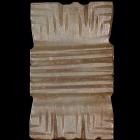J.J. Lally & Co., Oriental Art / New York City, New York
Menu36.
FIVE JADE PLAQUES OF ‘TIED BUNDLE’ FORM
Western Zhou Dynasty (1027 – 771 B.C.)
each carved on one side with clusters of three conjoined panels incised with parallel lines emerging above and below a deeply grooved central transverse band, which may be interpreted as a tied bundle of silk, the reverse plain and drilled with tiny perforations for stringing across the angles at the edges, the pale olive green jade showing remains of earth and cinnabar.
Length 1 11⁄16 inches (4.3 cm) each
Compare the jade plaques of this form strung in a collar of jades and agates discovered at the Western Zhou cemetery of the Guo State and now in the collection of the Shanghai Museum, illustrated by Zhang in Shanghai bowuguan cangpin yanjiu daxi: Zhongguo gudai yuqi (Research Series of the Shanghai Museum Collection: Ancient Chinese Jades), Shanghai, 2009, p. 124, no. 87, with description on p. 121, where the author suggests this form of jade plaque may be intended to represent a tied bundle of silk.
Compare also the jade plaques of similar form and design strung in a long necklace or pectoral of various jade ornaments excavated at the Western Zhou cemetery of the Jin State at the Tianma-Qucun site, Shanxi province, illustrated in Wenwu, 1995, No. 7, inside cover and on p. 16.
西周 束絹形玉佩五件 各長4.3厘米
